Abstract
Intercalibrated measurements of lead in calcium supplements indicate the importance of rigorous analytical techniques to accurately quantify contaminant exposures in complex matrices. Without such techniques, measurements of lead concentrations in calcium supplements may be either erroneously low, by as much as 50%, or below the detection limit needed for new public health criteria. In this study, we determined the lead content of 136 brands of supplements that were purchased in 1996. The calcium in the products was derived from natural sources (bonemeal, dolomite, or oyster shell) or was synthesized and/or refined (chelated and nonchelated calcium). The dried products were acid digested and analyzed for lead by high resolution-inductively coupled plasma-mass spectrometry. The method's limit of quantitation averaged 0.06 microg/g, with a coefficient of variation of 1.7% and a 90-100% lead recovery of a bonemeal standard reference material. Two-thirds of those calcium supplements failed to meet the 1999 California criteria for acceptable lead levels (1.5 microg/daily dose of calcium) in consumer products. The nonchelated synthesized and/or refined calcium products, specifically antacids and infant formulas, had the lowest lead concentrations, ranging from nondetectable to 2.9 microg Pb/g calcium, and had the largest proportion of brands meeting the new criteria (85% of the antacids and 100% of the infant formulas).
Full text
PDF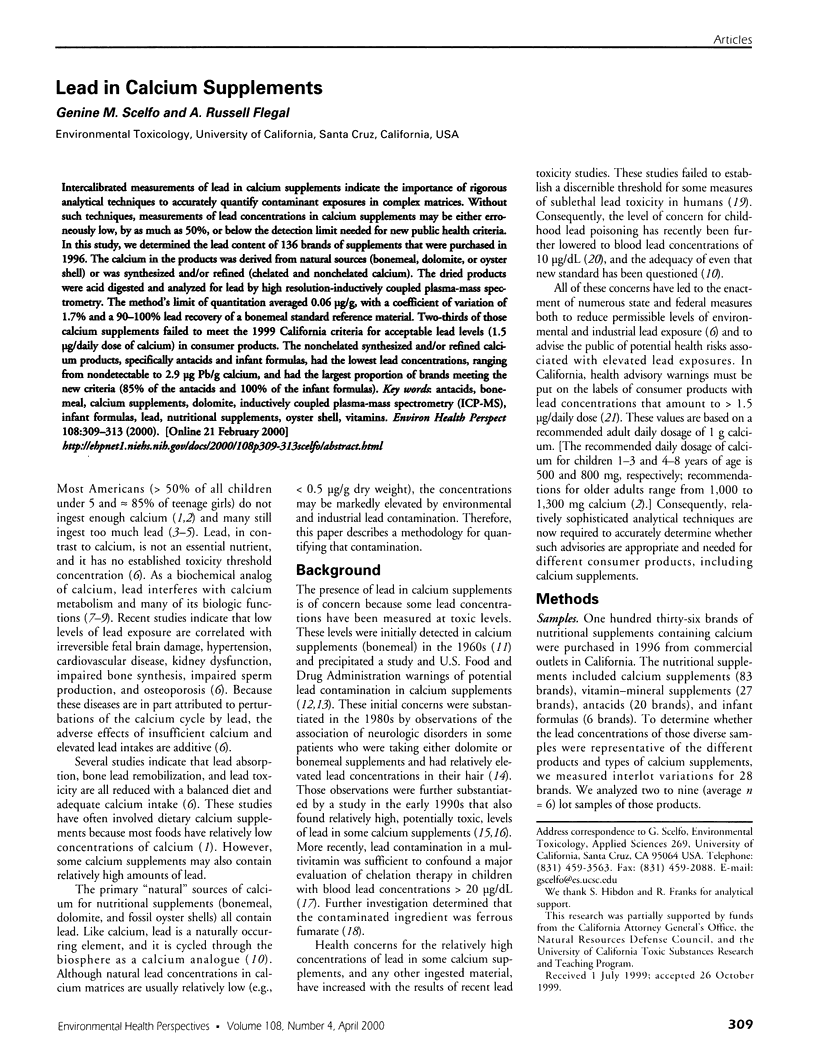
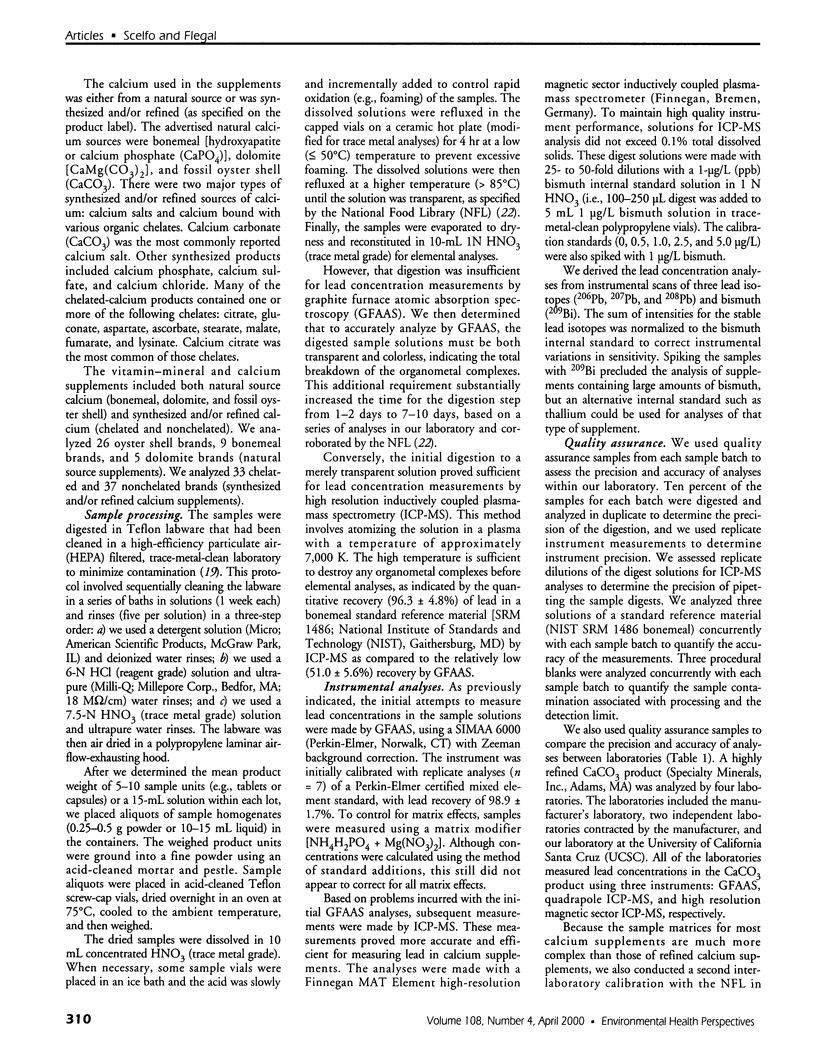
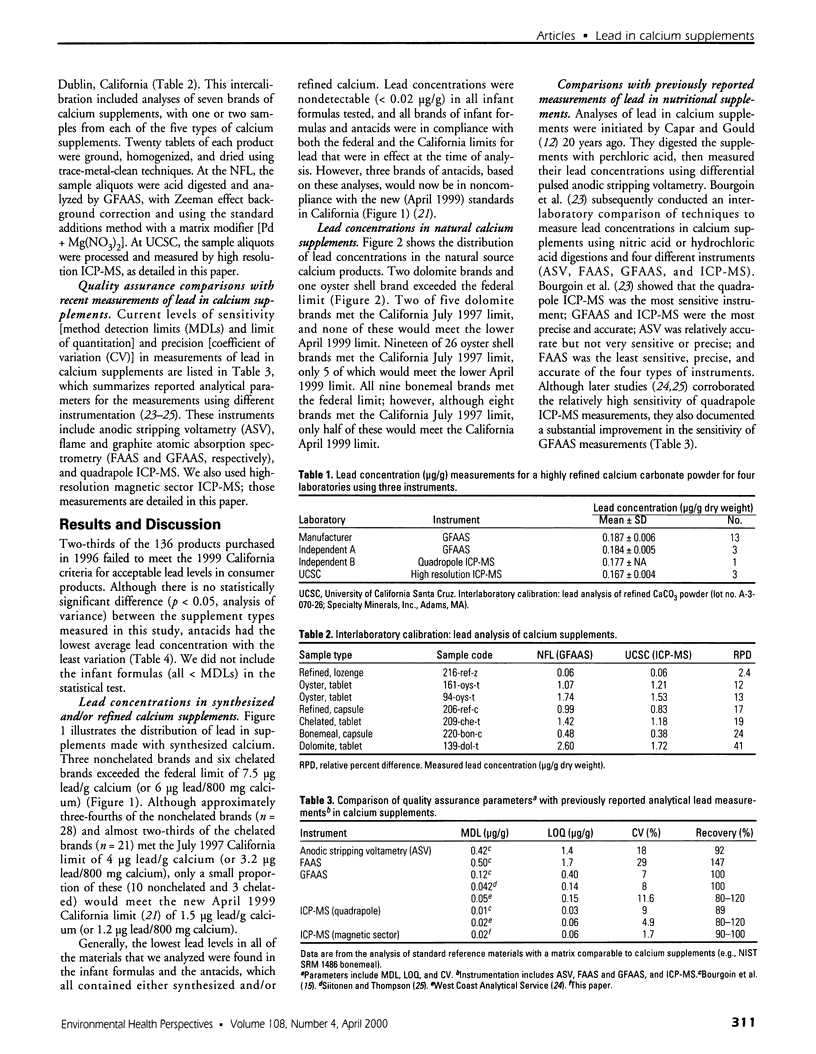
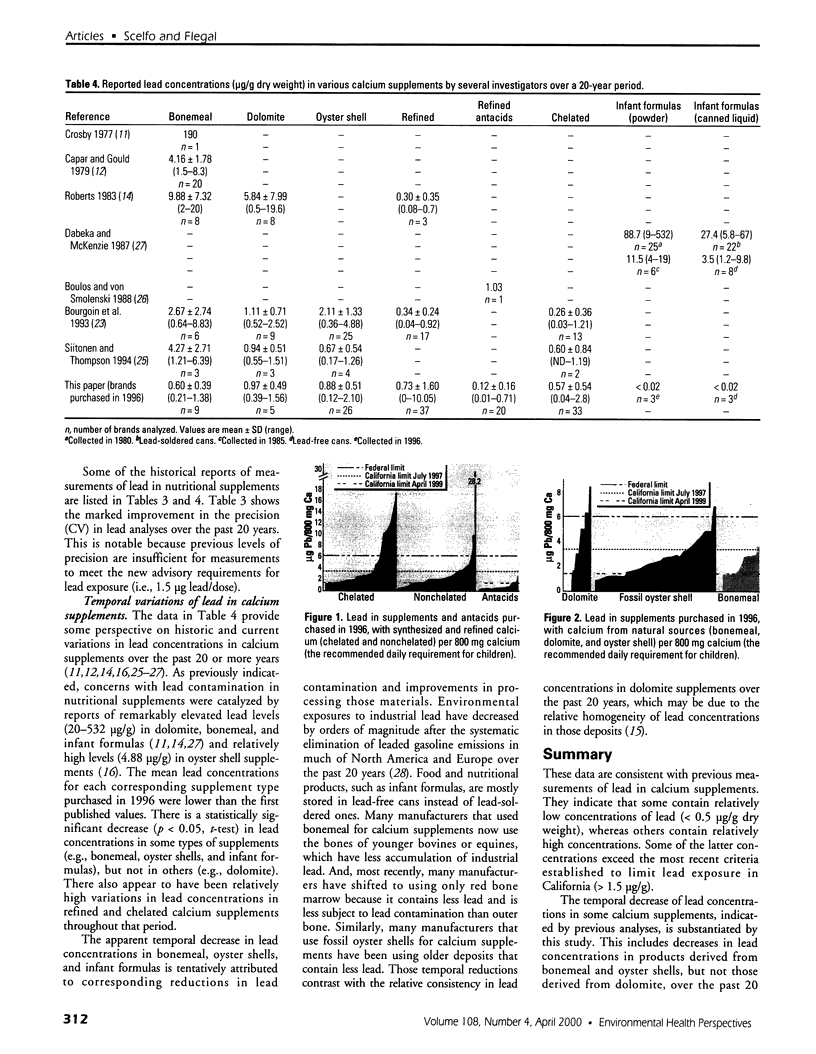
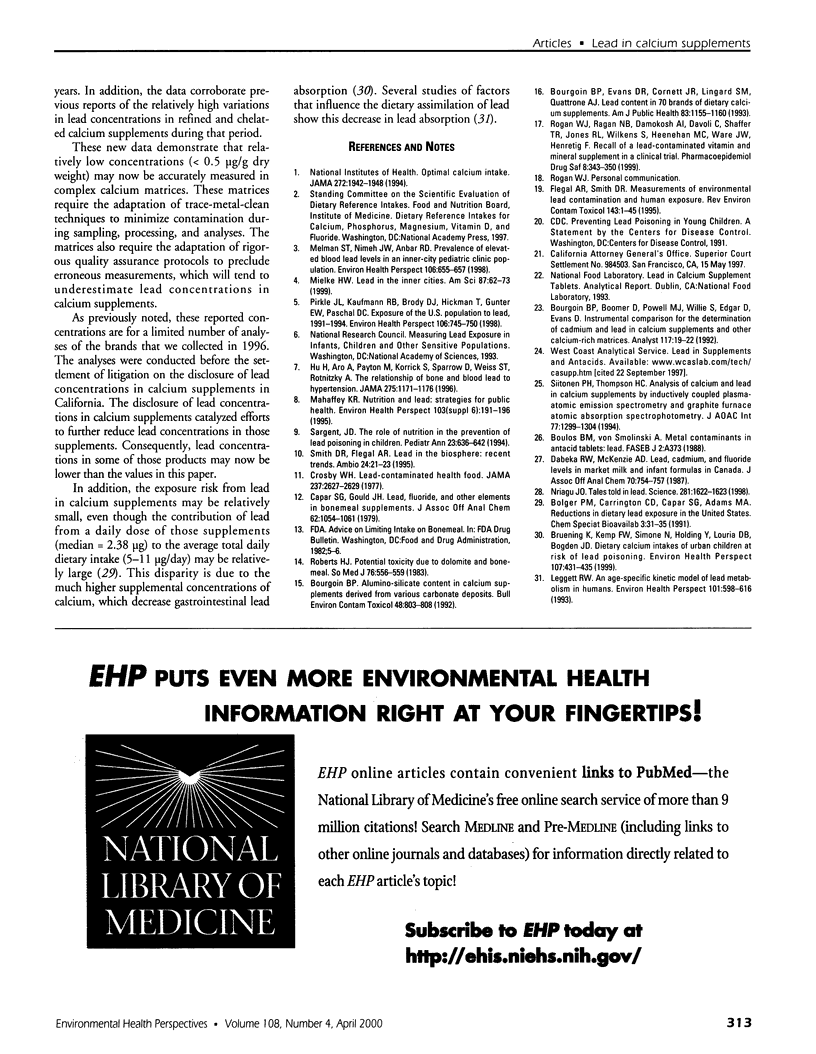
Images in this article
Selected References
These references are in PubMed. This may not be the complete list of references from this article.
- Bourgoin B. P. Alumino-silicate content in calcium supplements derived from various carbonate deposits. Bull Environ Contam Toxicol. 1992 Jun;48(6):803–808. doi: 10.1007/BF00201138. [DOI] [PubMed] [Google Scholar]
- Bourgoin B. P., Boomer D., Powell M. J., Willie S., Edgar D., Evans D. Instrumental comparison for the determination of cadmium and lead in calcium supplements and other calcium-rich matrices. Analyst. 1992 Jan;117(1):19–22. doi: 10.1039/an9921700019. [DOI] [PubMed] [Google Scholar]
- Bourgoin B. P., Evans D. R., Cornett J. R., Lingard S. M., Quattrone A. J. Lead content in 70 brands of dietary calcium supplements. Am J Public Health. 1993 Aug;83(8):1155–1160. doi: 10.2105/ajph.83.8.1155. [DOI] [PMC free article] [PubMed] [Google Scholar]
- Bruening K., Kemp F. W., Simone N., Holding Y., Louria D. B., Bogden J. D. Dietary calcium intakes of urban children at risk of lead poisoning. Environ Health Perspect. 1999 Jun;107(6):431–435. doi: 10.1289/ehp.99107431. [DOI] [PMC free article] [PubMed] [Google Scholar]
- Capar S. G., Gould J. H. Lead, fluoride, and other elements in bonemeal supplements. J Assoc Off Anal Chem. 1979 Sep;62(5):1054–1061. [PubMed] [Google Scholar]
- Crosby W. H. Lead-contaminated health food. Association with lead poisoning and leukemia. JAMA. 1977 Jun 13;237(24):2627–2629. [PubMed] [Google Scholar]
- Dabeka R. W., McKenzie A. D. Lead, cadmium, and fluoride levels in market milk and infant formulas in Canada. J Assoc Off Anal Chem. 1987 Jul-Aug;70(4):754–757. [PubMed] [Google Scholar]
- Flegal A. R., Smith D. R. Measurements of environmental lead contamination and human exposure. Rev Environ Contam Toxicol. 1995;143:1–45. doi: 10.1007/978-1-4612-2542-3_1. [DOI] [PubMed] [Google Scholar]
- Hu H., Aro A., Payton M., Korrick S., Sparrow D., Weiss S. T., Rotnitzky A. The relationship of bone and blood lead to hypertension. The Normative Aging Study. JAMA. 1996 Apr 17;275(15):1171–1176. [PubMed] [Google Scholar]
- Leggett R. W. An age-specific kinetic model of lead metabolism in humans. Environ Health Perspect. 1993 Dec;101(7):598–616. doi: 10.1289/ehp.93101598. [DOI] [PMC free article] [PubMed] [Google Scholar]
- Mahaffey K. R. Nutrition and lead: strategies for public health. Environ Health Perspect. 1995 Sep;103 (Suppl 6):191–196. doi: 10.1289/ehp.95103s6191. [DOI] [PMC free article] [PubMed] [Google Scholar]
- Melman S. T., Nimeh J. W., Anbar R. D. Prevalence of elevated blood lead levels in an inner-city pediatric clinic population. Environ Health Perspect. 1998 Oct;106(10):655–657. doi: 10.1289/ehp.106-1533171. [DOI] [PMC free article] [PubMed] [Google Scholar]
- Pirkle J. L., Kaufmann R. B., Brody D. J., Hickman T., Gunter E. W., Paschal D. C. Exposure of the U.S. population to lead, 1991-1994. Environ Health Perspect. 1998 Nov;106(11):745–750. doi: 10.1289/ehp.98106745. [DOI] [PMC free article] [PubMed] [Google Scholar]
- Roberts H. J. Potential toxicity due to dolomite and bonemeal. South Med J. 1983 May;76(5):556–559. doi: 10.1097/00007611-198305000-00005. [DOI] [PubMed] [Google Scholar]
- Rogan W. J., Ragan N. B., Damokosh A. I., Davoli C., Shaffer T. R., Jones R. L., Wilkens S., Heenehan M. C., Ware J. H., Henretig F. Recall of a lead-contaminated vitamin and mineral supplement in a clinical trial. Pharmacoepidemiol Drug Saf. 1999 Aug;8(5):343–350. doi: 10.1002/(SICI)1099-1557(199908/09)8:5<343::AID-PDS440>3.0.CO;2-Q. [DOI] [PubMed] [Google Scholar]
- Sargent J. D. The role of nutrition in the prevention of lead poisoning in children. Pediatr Ann. 1994 Nov;23(11):636–642. doi: 10.3928/0090-4481-19941101-12. [DOI] [PubMed] [Google Scholar]
- Siitonen P. H., Thompson H. C., Jr Analysis of calcium and lead in calcium supplements by inductively coupled plasma-atomic emission spectrometry and graphite furnace atomic absorption spectrophotometry. J AOAC Int. 1994 Sep-Oct;77(5):1299–1304. [PubMed] [Google Scholar]




